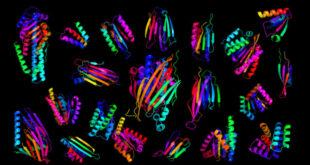A research team headed by scientists at the Salk Institute for Biological Studies has discovered that a combination of two molecules, alpha-KLOTHO (αKLOTHO) and TGF beta receptor 2 (TGFβR2), reverses the cellular and molecular signs of osteoarthritis in rats as well as in isolated human cartilage cells.
The top image shows a knee joint in a healthy rat (white indicates cartilage); the second image from top shows a joint with grade 2 untreated osteoarthritis; the third image shows a joint with osteoarthritis that has worsened from grade 2 to grade 4 after six weeks of placebo therapy; the bottom image shows a joint with osteoarthritis that improved from grade 2 to grade 1 (mild) after six weeks of combination therapy with αKLOTHO and TGFβR2. Image credit: Salk Institute.
Osteoarthritis, the most prevalent joint disease costing approximately 1-2.5% of the gross domestic product of developed countries, is caused by gradual changes to cartilage that cushions bones and joints.
During aging and repetitive stress, molecules and genes in the cells of this articular cartilage change, eventually leading to the breakdown of the cartilage and the overgrowth of underlying bone, causing chronic pain and stiffness.
Previous research had pinpointed αKLOTHO and TGFβR2 as potential drugs to treat osteoarthritis: αKLOTHO acts on the mesh of molecules surrounding articular cartilage cells, keeping this extra-cellular matrix from degrading; TGFβR2 acts more directly on cartilage cells, stimulating their proliferation and preventing their breakdown.
While each drug alone had only moderately curbed osteoarthritis in animal models of the disease, Salk Institute’s Professor Juan Carlos Izpisua Belmonte and his colleague wondered if the two drugs would act more effectively in concert.
“We thought that by mixing these two molecules that work in different ways, maybe we could make something better,” said Dr. Paloma Martinez-Redondo, a postdoctoral researcher in the Gene Expression Laboratory at the Salk Institute for Biological Studies.
The scientists treated young, otherwise healthy rats with osteoarthritis with viral particles containing the DNA instructions for making αKLOTHO and TGFβR2.
Six weeks after the treatment, the animals that had received control particles had more severe osteoarthritis in their knees, with the disease progressing from stage 2 to stage 4.
However, the rats that had received particles containing αKLOTHO and TGFβR2 DNA showed recovery of their cartilage: the cartilage was thicker, fewer cells were dying, and actively proliferating cells were present. These animals’ disease improved from stage 2 to stage 1, a mild form of osteoarthritis, and no negative side effects were observed.
“From the very first time we tested this drug combination on just a few animals, we saw a huge improvement. We kept checking more animals and seeing the same encouraging results,” said Dr. Isabel Guillen-Guillen, a researcher in the Gene Expression Laboratory at the Salk Institute for Biological Studies and the Universidad Católica San Antonio de Murcia.
Further experiments revealed 136 genes that were more active and 18 genes that were less active in the cartilage cells of treated rats compared to control rats.
Among those were genes involved in inflammation and immune responses, suggesting some pathways by which the combination treatment works.
To test the applicability of the drug combination to humans, the team treated isolated human articular cartilage cells with αKLOTHO and TGFβR2.
Levels of molecules involved in cell proliferation, extra-cellular matrix formation and cartilage cell identity all increased.
“That’s not the same as showing how these drugs affect the knee joint in humans, but we think it’s a good sign that this could potentially work for patients,” Dr. Martinez-Redondo said.
The study authors new plan to develop the treatment further, including investigating whether soluble molecules of the αKLOTHO and TGFβR2 proteins can be taken directly, rather than administered through viral particles. They also will study whether the combination of drugs can prevent the development of osteoarthritis before symptoms develop.
“We think that this could be a viable treatment for osteoarthritis in humans,” said Dr. Pedro Guillen, director of the Clinica CEMTRO.
The findings were published in the journal Protein Cell.
_____
P. Martinez-Redondo et al. αKLOTHO and sTGFβR2 treatment counteract the osteoarthritic phenotype developed in a rat model. Protein Cell, published online January 16, 2020; doi: 10.1007/s13238-019-00685-7

 #Bizwhiznetwork.com Innovation ΛI |Technology News
#Bizwhiznetwork.com Innovation ΛI |Technology News




